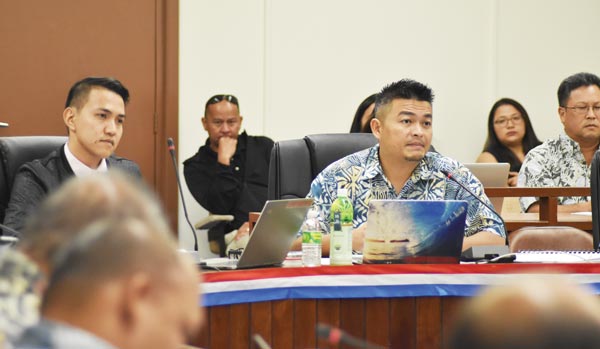‘PSS not ready for another typhoon’

Education Commissioner Glenn Muña, right, answers questions of members of the House Ways and Means Committee while PSS finance officer Chris Ching, left, looks on in yesterday’s budget hearing at the House chamber on Capital Hill. (Jon Perez)
The Public School System hopes it wouldn’t face another super typhoon in the next 10 to 15 years and is, in fact, not even ready for your run-of-the-mill typhoon, according to Education Commissioner Glenn Muña.
Acknowledging the long-shot nature of that wish, Muña noted that, as it stands, PSS has yet to recover fully from Super Typhoon Yutu, which devastated several PSS campuses in late October 2018.
“We are not ready for another typhoon season,” he said. “…We not only run an educational institution; we also run some of the island’s primary short-term shelters,” he said during yesterday’s annual budget hearing session with the House Committee on Ways and Means.
Muña noted that at least 10 PSS buildings are also designated as shelters.
While PSS shelters are intended as short-term shelters only, Super Typhoon Yutu was so destructive that PSS had no choice, but to operate them for over a month, he said.
In terms of expenses, August 2015’s Typhoon Soudelor was less expensive to recover from compared to Super Typhoon Yutu.
“Given our current financial situation and the current workflow that we have toward [Super Typhoon Yutu] recovery, we are not ready for another set of typhoons,” he said.
As a result of Super Typhoon Yutu, the CNMI government has implemented a government-wide belt-tightening, forcing PSS to halt full-time employee hiring and within-grade increases.
Besides the austerity measures, PSS is also thinking of decreasing the work-hours of its employees. The Board of Education has yet to approve that plan.
Yutu decimated the Herbert G. Hopwood Middle School in Chalan Piao, rendering the whole campus unusable and forcing its nearly 1,000 student population to continue their classes in tents right next to the Koblerville Elementary School.
The Francisco M. Sablan Middle School lost a whole building to the super typhoon, while Oleai Elementary School also sustained damage. Marianas High School, one of the several schools that were opened as a shelter, reported damage to some of their older buildings, including having the roof of their new gymnasium blown off.
Super Typhoon Yutu also forced the BOE to approve at their recent board meeting last week PSS’ recommendation to extend its summer break by a month to save a month’s worth of utility costs.
“My biggest worry are the temporary classrooms,” said Muña.
According to the Federal Emergency Management Agency, the temporary classroom tents can withstand winds of up to 120 mph, roughly the equivalent of a Category 3 typhoon.
Super Typhoon Yutu was a Category 5 typhoon with the highest recorded windspeeds of up to 177 mph.
“What is going to happen if a [Category 4 typhoon or stronger] hits the CNMI? Where are we going to get funding for that?” Muña asked. “As much as possible, we do repairs with the little money we get.
He assured, though, that continuing to provide services to the community is PSS’ priority.”























